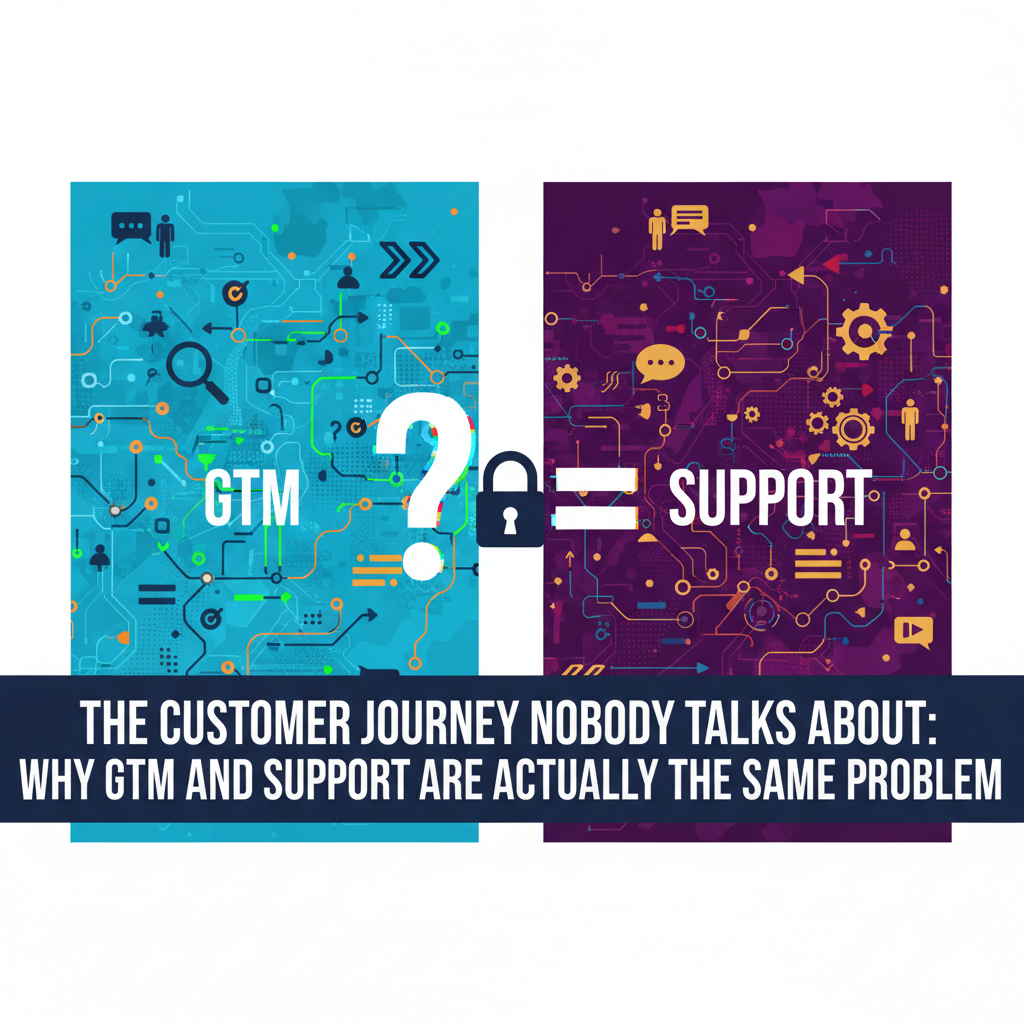There’s a moment in every startup’s growth that nobody prepares you for. You’ve nailed acquisition. Your GTM is working. The data is clean, your sequences are landing, deals are closing. Sales team is celebrating. Marketing is hitting targets. Then 30 days later, something shifts.
Your churn starts creeping up. Not catastrophically just enough to make you wonder. Customers aren’t complaining about your product. They’re complaining about feeling forgotten. Support tickets pile up across five different channels. Some customers get responses in hours. Others wait days. A few slip through entirely. The Irony is brutal: the same precision that got you the customer the segmentation, the targeting, the data disappears the moment they sign. It’s like you spent all this energy finding the right person to invite to dinner, and then seated them in the kitchen alone. The problem isn't new. The solution is:
For years, companies treated GTM and customer experience like separate universes. Sales and marketing owned acquisition. Support owned retention. They had different budgets, different tools, different KPIs. It worked when you were small. It falls apart when you scale.
Here's what's changed: the tools are better now. The data that powers your outbound workflows can also power your support operations. The automation that helps you reach customers faster can help you serve them faster too. But most companies still aren’t connecting those dots. A business might use enriched data to find the perfect prospect understanding their industry, their role, their likely pain points and then route that customer’s first support ticket to an overworked generalist who knows nothing about them. That’s not a failure of execution. That’s a failure of architecture.
● What happens when you actually connect them
Imagine this instead: A prospect comes in through your GTM motion. Your data has already identified what they care about. Your sales team has had a smart conversation. They onboard. Now they need support. But instead of starting from zero, the support system knows their context. Who they are. What they bought. What they said during the sales process. Support isn’t generic. It’s informed. It’s faster because it doesn’t have to ask basic questions. It’s better because someone actually understands what the customer is trying to do. That’s not complicated infrastructure. That’s just logical infrastructure.
The challenge is that most companies have built their tools and teams in silos. Your GTM platform doesn’t talk to your support system. Your CRM has data that your helpdesk doesn’t access. You’re automation is clever on one side of the customer journey and completely absent on the other.
● Why this matters more right now
We’re in a weird moment. Companies are getting better at sourcing and reaching customers through AI. Data enrichment is getting cheaper and more accurate. Outbound workflows are smarter. All of that is real progress. But here’s the uncomfortable truth: if you’re bringing in more customers through better targeting and automation, but your support can’t keep pace, you’re not actually growing. You’re just turning up the churn dial.
The math Is simple. A customer acquired through precise GTM work but lost through poor support doesn’t count as growth. It’s just expensive customer cycling.
● What actually needs to happen
This isn’t about having one unified platform that does everything. It’s about having systems that talk to each other and teams that think about the full journey. If you’re investing in better GTM data, that same data should inform your support operations. If you’re automating parts of your outbound workflow, you should be automating parts of your support workflow. If your sales team understands each customer’s context, your support team should too.
It means your support team needs access to the signals your GTM team is using. It means your automation should span the entire customer lifecycle, not just the acquisition phase. It means thinking about customer experience as something that starts before the sale, not after it.
It also means being realistic about what automation can and should do. The tools are good at routing, at handling repetitive requests, at pulling data and providing context. They’re terrible at actually caring about a customer’s problem. That part still requires a person who knows what they’re doing.
● The company that get this right do one thing differently
They stop thinking about acquisition and retention as separate problems solved by separate teams with separate data. Instead, they ask: What do we know about this customer at every stage? How do we use that knowledge to make their experience better? Where should humans be involved? Where should systems handle it? How do we make sure nothing gets lost in the transition?
Those questions are harder than “how do we improve our conversion rate” or “how do we reduce support costs.” But they’re the questions that actually create sustainable growth.
● What’s interesting is what’s not happening
You’d think this would be obvious by now. It’s not. Most startups still operate with the acquisition and retention completely divorced. Most support systems still treat customers like they’re starting fresh. Most GTM data sits in a silo and never informs what happens next. The companies winning right now are the ones who stopped treating customer data as something that belongs to the sales team or the support team. They treat it as something that belongs to the customer journey.
It doesn't require a complete platform overhaul. It requires intentional thinking about how the systems talk to each other and how the teams collaborate. It requires using the same precision on retention that you’re already using on acquisition. The funny part? When you actually do this, support stops feeling like a cost center. It starts feeling like what it actually is: the second half of your GTM strategy. And suddenly, those GTM metrics you’re so proud of start meaning something.
● One more thing: you don’t need to build this alone
Here’s what we see with companies that have figured this out: they usually didn’t rebuild everything from scratch. They picked their tools intentionally GTM platforms that provide clean, enriched data, and support platforms that can actually use that data to serve customers better. The shift doesn't require perfect internal infrastructure. It requires external partners who understand that context matters. Support platforms that can operate across email, chat, WhatsApp, and social without forcing your customers into one channel. Experoc, for example, is built around this exact principle they manage conversations across all those channels for startups and SMBs, but the key difference is they actually integrate customer context into every interaction. They’re not just routing tickets; they’re using the information you have about your customer to make support feel personal at scale.
Partners like these hire people who actually care about your customers’ problems, not just closing tickets. That matters more than you’d think.
The difference between outsourced support that feels like you fired your team and outsourced support that feels like an extension of your team is usually this: does the partner actually understand your business? Do they have the data they need? Are they empowered to solve problems, or are they just processing requests?
When those conditions are met, something interesting happens. You get the scale of outsourcing without losing the personal touch. You get the cost efficiency without sacrificing quality. And your GTM data finally flows all the way through to the people who can actually use it to make customers feel known. That’s when support becomes a growth lever instead of a cost.






